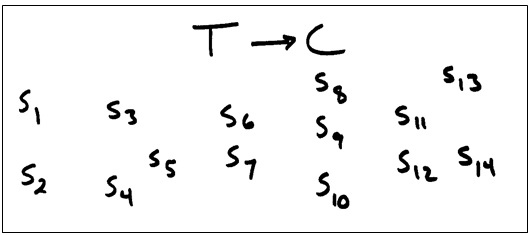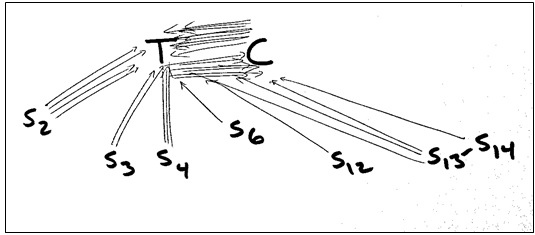|
| |
Applying a Verbal Flowchart Protocol in Classroom ObservationsErin N. O’Reilly, University of Illinois at Urbana-Champaign Classroom observations can assume many different forms tailored according to their purpose. Verbal flowcharts (also known as interactive flowcharts) have been around for decades (see DeBolt, 1992) and differ from a typical observation protocol in that they focus on the interactions between the teacher and the students, not necessarily the content of the lesson. A flowchart protocol traditionally consists of a classroom diagram which shows rows of desks in grid form. The observer gives each box a number representing a student and codes the interactions (e.g., chatting with a friend, asking a question, individual work, etc.). The flowchart's value is that it allows the observer to capture classroom interactions, documenting a wide range of behaviors, such as which students the teacher calls on to answer and whether certain students participate more than others. During the post-observation discussion, the flowchart itself serves to frame the dialogue on classroom management and activity design. Current language teaching methodologies highlight student-centered activities, with a heavy emphasis on interaction and production. In any given lesson, students may move around the classroom switching from individual, to pair, to small group work. The problem with the traditional setup for the verbal flowchart protocol is that it reflects a conventional, teacher-centered classroom. The grid method for the verbal flowchart becomes a clunky instrument in this setting. The article below outlines the steps to employ an adapted verbal flowchart protocol for the communicative language classroom, including coding interactions, students, and activities, as well as post-observation discussion questions. Coding Interactions There are four primary categories of classroom interaction; each has a description along with the shorthand used to code the observation protocol form:
Coding Students The next step is to identify the students. Using subscripts, each student receives a number (e.g., S1, S2, S3… ) linked to the student's name and physical location in the classroom. Occasionally the observer is fortunate enough to know the students; otherwise, coding students can require upfront coordination with the teacher. In classes with assigned seating, this may simply be a matter of requesting a seating chart. Another option is to request a class roster. Typically by the end of a one-hour observation in a class of 20 students, the observer can match most, if not all, of the coded students with their names through normal classroom activities. At the end of the class, the observer can pull the teacher aside to quickly go over the seating arrangement, adding missing names to the student codes. Coding Activities The key challenge to employing a verbal flowchart is that language classrooms tend to be dynamic, incorporating activities which have students moving around and changing pairs throughout a lesson. To overcome this challenge, the observer divides each activity into its own chart. By the end of the lesson, there may be 5 or more charts representing these activities. Below are three flowcharts taken from an observation: the introduction, a pair work activity, and the pair work review activity. Figure 1 shows the initial setup of the classroom; students came in, randomly sat down and were coded by the observer. Figure 1 also shows the teacher giving directions to the entire class indicated by a one-way arrow (T → C).  Figure 1. Initial classroom setup.
Figure 2 shows the students engaged in a pair work activity. The lines between the student and the teacher indicate interactions, with arrows identifying who initiated the interaction (e.g., S1 → T means that Student 1 asked a question.). Each line between the S and the T represents an additional interaction; the more lines between a particular student and the teacher, the more questions the student asked (see Student 2 in Figure 2).  Figure 2. Pair work activity
Finally, Figure 3 shows the pair work review activity. The majority of the interactions are coded as T-C, or teacher-to-class open question and choral response. In the review activity the teacher did not call on specific students to respond; however the flowchart again shows that Student 2 is highly-engaged with the lesson. Not all students are coded separately in this activity, reflecting that they did not answer individually.  Figure 3. Pair work review activity.
Post-Observation Discussion Many factors influence classroom interactions, from where the students sit (i.e., Does the teacher habitually interact with one half of the class?), to cultural considerations (i.e., Do students from certain L1 groups dominate or withdraw?), to proficiency barriers (i.e., Are the activities appropriate for a multilevel classroom?). The post-observation discussion questions can elicit a range of insights the teacher may have about his/her class, but not necessarily articulated prior to seeing the visual flowchart. As each activity is divided into its own flowchart, the teacher and observer can compare the changes in student interactions (if any) based on activity type. Below are questions to guide the post-observation discussion:
Reference DeBolt, G.P. (1992). Teacher induction and mentoring: School-based collaborative programs. New York, NY: SUNY Press. Erin N. O’Reilly is the director of the Intensive English Institute at the University of Illinois at Urbana-Champaign.
| |
| ITBE Link - Summer 2015 - Volume 43 Number 2 |